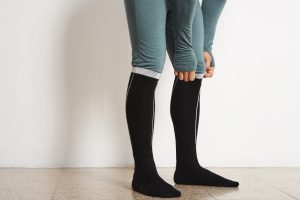Introduction
After undergoing surgery or during long periods of sitting, individuals are at an increased risk of developing blood clots, a condition known as thrombosis. Compression socks, also known as thrombosis socks, play a crucial role in preventing this potentially life-threatening condition. In this article, we’ll explore what thrombosis is, why compression socks are important, and provide tips for wearing them during travel and daily life.
What is Thrombosis?
Thrombosis refers to the formation of blood clots within the veins, typically occurring in the legs. When blood clots form, they can obstruct blood flow, leading to pain, swelling, and potentially severe complications if the clot breaks loose and travels to the lungs, causing a pulmonary embolism. Individuals who have recently undergone surgery or spend long periods sitting, such as during air travel, are particularly susceptible to thrombosis.

Formation of a blood clot
Why is it important to wear compression socks after surgery?
Compression socks exert gentle pressure on the legs, promoting blood circulation and preventing the pooling of blood in the veins. By improving blood flow, compression socks reduce the risk of blood clots forming in the legs and lower the likelihood of developing thrombosis. For individuals recovering from surgery or spending extended periods sitting, wearing compression socks is an essential measure to protect against thrombosis and promote overall vascular health.

How to wear compression socks correctly?
- Choose the Right Fit: Compression socks come in various sizes and compression levels. Select socks that fit snugly but comfortably around the legs without causing discomfort or restricting circulation.
- Wear Them Consistently: Whether traveling by plane, sitting at a desk for work, or recovering from surgery, wear compression socks consistently to maintain optimal blood flow and reduce the risk of thrombosis.
- Stay Hydrated and Move Regularly: Stay hydrated during travel and take regular breaks to stretch and move around, especially during long flights or car rides. Movement helps stimulate blood circulation and prevents blood from pooling in the legs.
- Elevate Your Legs: When possible, elevate your legs above heart level to encourage blood flow back to the heart and reduce swelling and discomfort.

Conclusion
In conclusion, thrombosis socks play a vital role in preventing blood clots and maintaining vascular health, particularly during periods of inactivity such as post-surgery recovery or long-distance travel. By promoting proper blood circulation and reducing the risk of thrombosis, compression socks offer a simple yet effective solution to protect against potentially serious health complications. Whether traveling by plane, sitting for extended periods, or recovering from surgery, wearing compression socks is a proactive measure to safeguard against thrombosis and promote overall well-being. Incorporating compression socks into daily life can help individuals stay active, comfortable, and healthy, ensuring a smooth recovery and enjoyable travel experiences.
Disclaimer: The content on this blog is intended for general informational purposes only. It is not a substitute for professional medical advice, diagnosis, or treatment. Always consult qualified healthcare providers for personalized advice. Information regarding plastic surgery, dental treatment, hair transplant, and other medical procedures is educational and not a guarantee of results. We do not assume liability for actions taken based on blog content. Medical knowledge evolves; verify information and consult professionals. External links do not imply endorsement. By using this blog, you agree to these terms.





